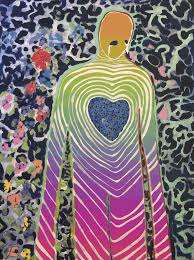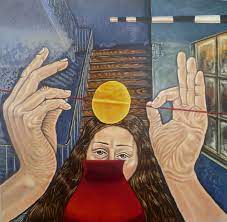 The Columbia City Yoga on-line Moving into Meditation classes met this morning. This week we explored the qualities of empathy and compassion. We practiced a compassion meditation in which we directed caring and compassionate phrases to someone who is suffering. The practice can help us turn toward suffering while offering our loving presence. In the expansive presence of loving awareness we gain perspective as to what might serve to alleviate suffering.
The Columbia City Yoga on-line Moving into Meditation classes met this morning. This week we explored the qualities of empathy and compassion. We practiced a compassion meditation in which we directed caring and compassionate phrases to someone who is suffering. The practice can help us turn toward suffering while offering our loving presence. In the expansive presence of loving awareness we gain perspective as to what might serve to alleviate suffering.
We drew inspiration from mediation teacher and author Sharon Salzberg’s new book, Real Life: The Journey from Isolation to Openness and Freedom. In Real Life, Sharon encourages readers to live more expansively. When we live expansively, we have room to experience both positive and negative emotions and to view them with openness and curiosity rather than restriction and resistance. When we are willing to experience emotion we develop our capacity to extend compassion to ourselves and others.
Last week we explored our original goodness. A goodness from which the qualities of kindness, compassion, appreciative joy and equanimity arise. In relationship with others this goodness gives rise to empathy and compassion. In classic Buddhism students are encouraged to cultivate compassion or Karuna. Karuna is a Pali word that means “to experience a trembling or quivering of the heart,” or the spontaneous expression of compassion.
I’ve recently learned that there is a difference difference between empathy and compassion. In empathy, one recognizes the suffering in another and feels it in themselves. At times there may be a sense of taking the suffering onto one’s self. Compassion expresses care along with empathy and the willingness to help or serve. This helping begins and sometimes ends with our caring, clear presence. Compassionate presence enables one to recognize suffering without judgment or despair.
We can cultivate compassion with Karuna meditation. It’s a heart expanding practice in which we can experience clarity, hope and love. This practice can help us to accept that suffering is a common, natural part of life. It can gradually transform our relationship to suffering. Imagine for a moment, what it would be like to express caring and kindness with a sense of clarity, and a quality of presence that would enable you to sense what will best serve to relieve this person’s suffering. This may not mean that a disease is cured or a life is saved. It’s the possibility that the anguish, pain, aversion grasping or attachment that tend to arise with suffering can be released or loosened. Compassion includes the hope that the person suffering may be freed from the things that prevent inner peace. It’s a powerful practice, a lifelong practice.
 Let’s explore it together. I invite you to adjust your posture as you need. Establish a comfortable steady seat or even lie down. Your hands can rest in your lap or relax at your sides if you’re reclining. If you like, you can close your eyes. Take a few slow relaxing breaths to help bring you into the present moment. Connect with the breath. Connect with your body. You might move your awareness through your body and feel the areas that ground and support you. Let yourself feel this support. You might take a few moments to consider consider your experience with empathy and compassion. Recall your past experiences of these qualities. How did you feel in your body? Your heart? Your mind?
Let’s explore it together. I invite you to adjust your posture as you need. Establish a comfortable steady seat or even lie down. Your hands can rest in your lap or relax at your sides if you’re reclining. If you like, you can close your eyes. Take a few slow relaxing breaths to help bring you into the present moment. Connect with the breath. Connect with your body. You might move your awareness through your body and feel the areas that ground and support you. Let yourself feel this support. You might take a few moments to consider consider your experience with empathy and compassion. Recall your past experiences of these qualities. How did you feel in your body? Your heart? Your mind?
Invite into your mind’s eye the image of someone who is experiencing physical or mental suffering. This could be someone you are caring for or someone you know who is facing suffering. I’ll say a line of Karuna. As you sense this person you care for repeat the phrase saying it silently or out loud. Direct kindness toward this person. “May you be free of your pain and sorrow.” “May you find peace.” And again. “May you be free of your pain and sorrow.” “May you find peace.” With care with hope again. “May you be free of your pain and sorrow.” “May you find peace.” “May you be free of your pain and sorrow.” “May you find peace.” Allow your breath to deepen directing those compassionate words out towards this person experiencing suffering.
Gradually allow that image to dissolve. Bring into your mind’s eye the image of yourself either the image of yourself in this moment or any moment in your life when you’ve experienced suffering. Let that image grow clear in your mind. Again I’ll say a line of Karuna and you repeat that line directing those compassionate words towards yourself. “May I be free of pain and sorrow.” “May I find peace.” You might visualize yourself thriving as we repeat again “May I be free of pain and sorrow.” “May I find peace.” With tenderness. “May I be free of pain and sorrow.” “May I find peace.” “May I be free of pain and sorrow.” “May I find peace.” As the breath deepens absorb those compassionate words. Now allow that image to gradually fade.
 Release the Karuna meditation release. Let your awareness move through your body and your mind. Notice what you feel. This practice evokes emotions. Feel your breathing and remain present with your emotions. Be with them as you would be with a good friend. If sorrow or fear is present you can always move into loving kindness and offer yourself phrases of well being. Loving kindness practice can help you to restore balance. You can always return to compassion meditation, acknowledging suffering, opening up to it and responding to it with courage and tenderness of heart.
Release the Karuna meditation release. Let your awareness move through your body and your mind. Notice what you feel. This practice evokes emotions. Feel your breathing and remain present with your emotions. Be with them as you would be with a good friend. If sorrow or fear is present you can always move into loving kindness and offer yourself phrases of well being. Loving kindness practice can help you to restore balance. You can always return to compassion meditation, acknowledging suffering, opening up to it and responding to it with courage and tenderness of heart.
Here is how Sharon Salzberg describes compassion in her new book, Real Life:
I think about the face of love that recognizes suffering: compassion. In compassion, love is laced through with tenderness . . . “Would that I could just go poof and relieve you of all pain. But life just isn’t like that.” This may not be highly emotional, yet it is love, and even more specifically, love supported by wisdom. While judgment is monolithic and fixed, compassion is complex and expansive, an evolving part of a living system. It accommodates the reality that we operate within the fragility of life, the difficult transfer of intention and impact, and personal imperfection in nearly every moment of the day. We see we can open to suffering – our own and others’ – without getting engulfed by it, and we see that despite strategies and plans and tactics, loving presence is the most healing force of all.
May we give and receive compassion. May we, alone and together, offer the healing force of loving presence to all beings.

